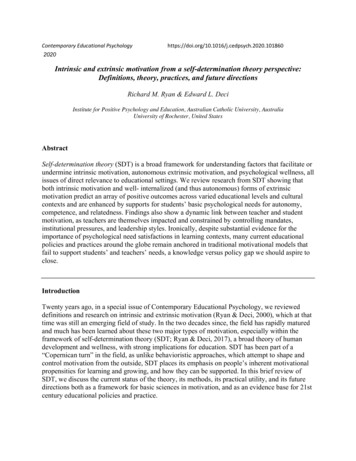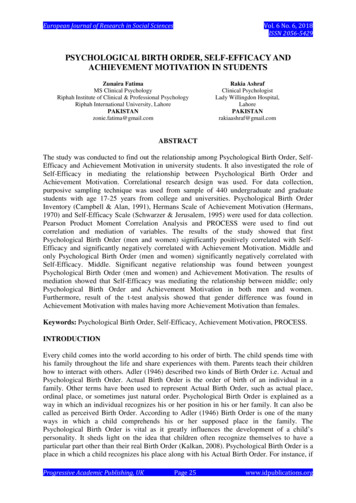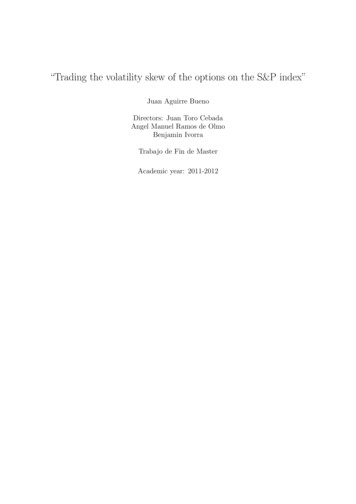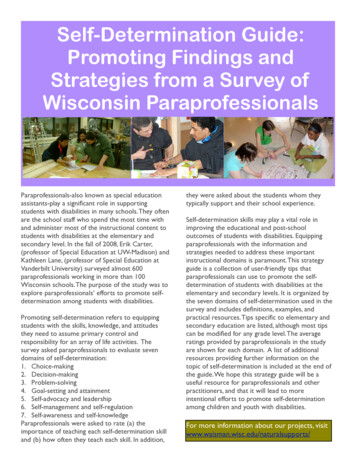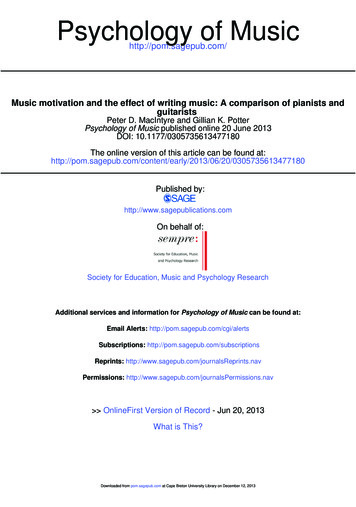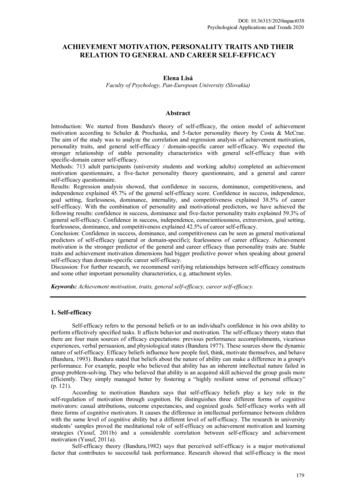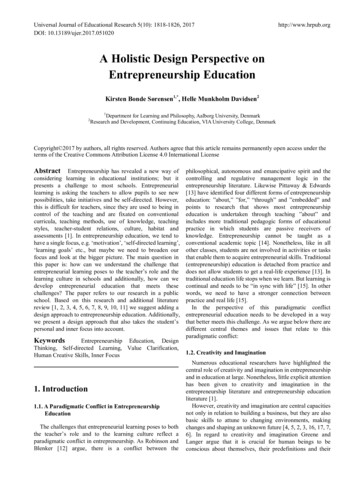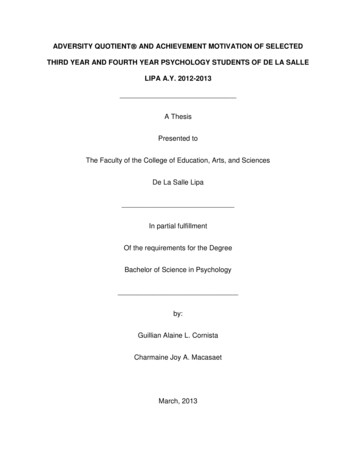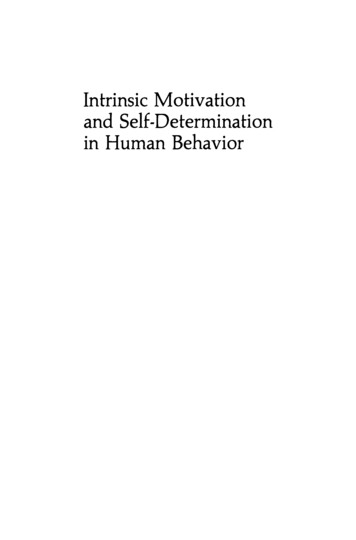
Transcription
Intrinsic Motivationand Self-Determinationin Human Behavior
PERSPECTIVES IN SOCIAL PSYCHOLOGYA Series of Texts and Monographs Edited by Elliot AronsonINTRINSIC MOTIVATIONBy Edward L. OedSCHOOL DESEGREGATIONBy Harold B. Gerard and Norman MillerHUMAN AGGRESSIONBy Robert A. BaronUNIQUENESS: The Human Pursuit of DifferenceBy C. R. Snyder and Howard L. FromkinSCHOOL DESEGREGATION: Past, Present, and FutureEdited by Walter G. Stephan and Joe R. FeaginTHE BELIEF IN A JUST WORLD: A Fundamental DelusionBy Melvin J. LernerNONVERBAL BEHAVIOR AND SOCIAL PSYCHOLOGYBy Richard Heslin and Miles PattersonINTRINSIC MOTIVATION AND SELF-DETERMINATION IN HUMAN BEHAVIORBy Edward L. Oed and Richard M. RyanTHE PHYSICAL ATTRACTIVENESS PHENOMENABy Gordon L. PatzerREDEFINING SOCIAL PROBLEMSEdited by Edward Seidman and Julian RappaportA Continuation Order Plan is available for this series. A continuation order will bring delivery ofeach new volume immediately upon publication. Volumes are billed only upon actual shipment. Forfurther information please contact the publisher.
Intrinsic Motivationand Self-Determinationin Human BehaviorEdward L. DeciandRichard M. RyanUniversity of RochesterRochester, New YorkSPRINGER SCIENCE BUSINESS MEDIA. LLC
library of Congress Cataloging in Publication DataOed, Edward L.Intrinsic motivation and self·determination in human behavior.(Perspectives in social psychology)Bibliography: p.Includes index.1. Intrinsic motivation. 2. Psychology-Philosophy. 3. Personality. I. Ryan,Richard M. ll. Title. III. Title: Self·determination in human behavior. IV. Series.BF503.D43 1985153.885·12413ISBN 978-1-4899-2273-1ISBN 978-1-4899-2271-7 (eBook)DOI 10.1007/978-1-4899-2271-710987654 1985 Springer Science Business Media New YorkOriginally published by Plenum Press, New York in 1985Softcover reprint of the hardcover 1st edition 1985All rights reservedNo part of this book may be reproduced, stored in a retrieval system, or transmitted,in any form or by any means, electronic, mechanical, photocopying, microfilming,recording, or otherwise, without written permission from the Publisher
To Our Parents:Janice M. and Charles H. OedJean M. and C. James Ryan
PrefaceEarly in this century, most empirically oriented psychologists believedthat all motivation was based in the physiology of a set of non-nervoussystem tissue needs. The theories of that era reflected this belief andused it in an attempt to explain an increasing number of phenomena.It was not until the 1950s that it became irrefutably clear that muchof human motivation is based not in these drives, but rather in a set ofinnate psychological needs. Their physiological basis is less understood;and as concepts, these needs lend themselves more easily to psychological than to physiological theorizing. The convergence of evidencefrom a variety of scholarly efforts suggests that there are three suchneeds: self-determination, competence, and interpersonal relatedness.This book is primarily about self-determination and competence(with particular emphasis on the former), and about the processes andstructures that relate to these needs. The need for interpersonal relatedness, while no less important, remains to be explored, and the findingsfrom those explorations will need to be integrated with the presenttheory to develop a broad, organismic theory of human motivation.Thus far, we have articulated self-determination theory, which is offeredas a working theory-a theory in the making. To stimulate the researchthat will allow it to evolve further, we have stated self-determinationtheory in the form of minitheories that relate to more circumscribeddomains, and we have developed paradigms for testing predictions fromthe various minitheories.In working toward a broad motivation theory, we hope to contributeto the accelerating movement toward a motivational analysis of humanfunctioning. For the past several years, theorists have been increasinglyturning to motivational variables as central explanatory concepts in orderto explain phenomena that were not well handled by previous theoriesthat focused exclusively on behavioral or cognitive variables.vii
viiiPREFACEOur goal is to develop a truly organismic theory within empiricalpsychology. By assuming human agency (i.e., an active organism), byexploring the needs, processes, and structures that relate to it, and byexploring both the possibilities for and the limitations to human agency,we are attempting to explicate the dialectic of the organism's acting onand being acted upon by the social and physical environments. Sincemetatheories can be judged in part by the coherence and empirical utilityof the theories that are built upon their foundation, we have tried todevelop a theoretical framework that would give credence to this philosophical perspective.Finally, our overriding, sociopolitical interest is examining the possibilities and obstacles for human freedom. In our thinking, this pertainsnot only to social, political, and economic structures, but also to internalpsychological structures that reflect and anchor the external ones. It isour hope that, by engaging in a serious investigation of motivationalissues, we can make some small contribution toward the larger goal ofhuman freedom.Preparation of this book, along with some of the research describedin it, was supported by a grant from the National Science Foundation(BNS 8018628) and by the Xerox Corporation, through the efforts of JohnW. Robinson. The Department of Psychology at the University of Rochester has also supported our efforts. We are deeply indebted to all threeorganizations for helping to make this project possible.For the past few years, we have been working to create the HumanMotivation Program at the University of Rochester. Through the juxtaposition of scholars interested in motivation from the divergent viewpoints of social, developmental, personality, and clinical psychology,we have been able to stimulate dialogue, to facilitate research and scholarship, and to provide doctoral training in motivation as it relates tothose basic areas and to their applied ramifications. Much of the workpresented in this book has been done in collaboration with other peopleaffiliated with the Human Motivation Program. In particular, James P.Connell has worked closely with us in developing the theory of internalization that appears in Chapters 5 and 9. We are indebted to Jim aswell as to other faculty members in the Department of Psychology withwhom we have collaborated, and we are grateful to all of the graduatestudents who have contributed to the research effort. We would especially like to acknowledge the significant empirical contributions of WendyGrolnick, Richard Koestner, and Robert Plant. In addition, we expressour appreciation for the efforts of our colleagues at other universitieswho have contributed greatly toward an explication of the issues raisedin this book. Robert J. Vallerand made comments on several chapters
PREFACEixof the book, and Elliot Aronson has been an important source of moralsupport. We thank both of them.Betsy Whitehead did a heroic job of typing and editing the manuscript. Not only did she continually retype to keep up with our rewritingand with new word processing systems, but she continually spottederrors and inconsistencies in construction and content. We thank Betsy,and we also thank Cathy Ward and Shirley Tracey for their clericalassistance.EDWARD L. DECIRICHARD M. RYAN
ContentsPART I: BACKGROUND1. An Introduction . . . . . . . . . . . . . . . . . . . . . . . . . . . . . . . . . . . . . . . . . . .3Motivation Theories . . . . . . . . . . . . . . . . . . . . . . . . . . . . . . . . . .Drive Theories . . . . . . . . . . . . . . . . . . . . . . . . . . . . . . . . . . . . .Intrinsic Motivation. . . . . . . . . . . . . . . . . . . . . . . . . . . . . . . . .Self-Determination. . . . . . . . . . . . . . . . . . . . . . . . . . . . . . . . .Alternative (Nonmotivational) Approaches. . . . . . . . . . . .The Organismic Approach . . . . . . . . . . . . . . . . .Self-Determination Theory: An Overview. . . . . . . . . . . . . .34557892. Conceptualizations of Intrinsic Motivation and Self-Determination.11Historical Background . . . . . . . . . . . . . . . .Empirical Drive Theory . . . . . . . . . . . . . . . . . . . . . . . . . . . .Psychodynamic Drive Theory. . . . . . . . . . . . . . . . . . . . . . .White's Proposal. . . . . . . . . . . . . . . . . . . . . . . . . . . . . . . . . . .Optimal Stimulation. . . . . . . . . . . . . . . . . . . . . . . . . . . . . . . . .Optimal Arousal .Optimal Incongruity . . . . . . . . . . . . . . . . . . . . . . . . . . . . . . .Needs and Affects. . . . . . . . . . . . . . . . . . . . . . . . . . . . . . . . . . .The Need for Competence .Interest-Excitement and Flow. . . . . . . . . . . . . . . . . . . . . . .The Need for Self-Determination. . . . . . . . . . . . . . . . . . . .Intrinsic Motivation Conceptualized. . . . . . . . . . . . . . . . . . .Self-Determination: A Brief History. . . . . . . . . . . . . . . . . . .Self-Determination Conceptualized. . . . . . . . . . . . . . . . . . . .Summary .111218192020222626282932353839xi
CONTENTSxiiPART II: SELF-DETERMINATION THEORY3. Cognitive Evaluation Theory: Perceived Causality and PerceivedCompetence. . . . . . . . . . . . . . . . . . . . . . . . . . . . . . . . . . . . . . . . . . . . . . 43The Effects of Monetary Rewards . .Perceived Causality: Internal to External . .Other Extrinsic Rewards . .Reward Salience and Expectancy . .Constraints and Other Extrinsic Factors . .Perceived Causality: External to Internal . .Perceived Competence: Increases . .Perceived Competence: Decreases . .Cognitive Evaluation Theory . .Proposition I . .Proposition II . .Proposition III ., . .Evolution of the Theory . .Motivationally Relevant Processes . .Reward Administration and Types of Tasks . .Reward Contingencies . '. .The Nature of the Task . .Summary .4449495254575860626263636465727281854. Cognitive Evaluation Theory: Interpersonal Communication andIntrapersonal Regulation . . . . . . . . . . . . . . . . . . . . . . . . . . . . . . . . . . .87Interpersonal Contexts. . . . . . . . . . . . . . . . . . . . . . . . . . . . . . .Performance-Contingent Rewards. . . . . . . . . . . . . . . . . . .Positive Feedback . . . . . . . . . . . . . . . . . . . . . . . . . . . .Self-Administration. . . . . . . . . . . . . . . . . . . . . . . . . . . . . . . .The Meaning of Controlling . . . . . . . . . . . . . . . . . . . . . . . .The Meaning of Informational . . . . . . . . . . . . . . . . . . . . . .The Communicator and the Context .Characteristics of the Perceiver/Recipient .Sex Differences: Information and Control. . . . . . . . . . . . .Individual Differences in the Perceiver . . . . . . . . . . . . . .Intrapersonal Regulation: Information and Control .Proposition IV ,. . . . . . . . . . . . . . . . . . . . . . . . . . . . . . . . . . . .Experimentallnvestigations .Self-Determination and Causality . . . . . . . . . . . . . . . . . . . . .Summary .888891939596989999102105107108111112
CONTENTSxiii5. Toward an Organismic Integration Theory: Motivation andDevelopment . . 113The Nature of Development .The Organismic Integration Process .Intrinsic Motivation and Development. . . . . . . . . . . . . . . . .Intrinsically Motivated Behavior .The Effects of the Environment. . . . . . . . . . . . . . . . . . . . .The Development of Intrinsic Motivation . . . . . . . . . . . .Extrinsic Motivation and Development . . . . . . . . . . . . . . . .Evidence for Internalization .Internalization and the Integrative Process. . . . . . . . . . .Individual Differences in Children's Self-Regulation .Internalization and the Environment .Summary. . . . . . . . . . . . . . . . . . . . . . . . . . . . . . . . . . . . . . . . . . .1131161201211221271291321331401431476. Causality Orientations Theory: Personality Influences on Motivation 149Behaviors and Initiating Events. . . . . . . . . . . . . . . . . . . . . . .Causality Orientations . . . . . . . . . . . . . . . . . . . . . . . . . . . . . . .The Autonomy Orientation. . . . . . . . . . . . . . . . . . . . . . . . .The Control Orientation .The Impersonal Orientation . . . . . . . . . . . . . . . . . . . . . . . .The Development of Causality Orientations. . . . . . . . . .The General Causality Orientations Scale . . . . . . . . . . . . . .Self-Determination .Self-Actualization .Self-Esteem. . . . . . . . . . . . . . . . . . . . . . . . . . . . . . . . . . . . . . .Locus of Control .Self-Consciousness .Other Constructs. . . . . . . . . . . . . . . . . . . . . . . . . . . . . . . . . .Emotions and Attitudes .Behaviors .Summary of Scale Development .Summary 75PART III: ALTERNATIVE APPROACHES7. Operant and Attributional Theories. . . . . . . . . . . . . . . . . . . . . . . . . . 179Operant Theory . . . . . . . . . . . . . . . . . . . . . . . . . . . . . . . . . . . . . 180Rewards and Response Rates. . . . . . . . . . . . . . . . . . . . . . . 181"Failures" to Replicate . . . . . . . . . . . . . . . . . . . . . . . . . . . . . 182
xivCONTENTSCompeting Responses and Boredom . . . . . . . . . . . . . . . .The Focus of One's Analysis .Summary. . . . . . . . . . . . . . . . . . . . . . . . . . . . . . . . . . . . . . . . .Cognitive Approaches . . . . . . . . . . . . . . . . . . . . . . . . . . . . . . .Interpersonal Attributions .Attribution Theories .Attributing Motivation .Self-Attributions .Perceiving Intrinsic Motivation in Oneself and Others .Metatheoretical Considerations . . . . . . . . . . . . . . . . . . . . . . .Summary .1841851881891901911942002062082118. Information-Processing Theories . . . . . . . . . . . . . . . . . . . . . . . . . . . . . 213Expectancy Theories. . . . . . . . . . . . . . . . . . . . . . . . . . . . . . . . .Vroom's Model .Atkinson's Model .The Issue of Task Difficulty .Bandura's Theory .Hunt's Theory .Inadequacies of the Cognitive Theories. . . . . . . . . . . . . .Self-Determination Theory: An Information-ProcessingRepresentation .Inputs of Information. . . . . . . . . . . . . . . . . . . . . . . . . . . . . .Causality Orientations . . . . . . . . . . . . . . . . . . . . . . . . . . . . .Self-Determined Behavior . . . . . . . . . . . . . . . . . . . . . . . . . .Non-Self-Determined Behavior .Summary .215215218221223225228229229231231239242PART IV: APPLICATIONS AND IMPLICATIONS9. Education . 245Intrinsic Motivation in the Classroom .Classroom Structure . . . . . . . . . . . . . . . . . . . . . . . . . . . . . . .The Interpersonal Context: Teachers' Orientations .Intrinsically Motivated Learning . . . . . . . . . . . . . . . . . . . . . .Extrinsic Motivation in the Classroom. . . . . . . . . . . . . . . . .Reinforcement Programs. . . . . . . . . . . . . . . . . . . . . . . . . . .Organismic Integration .Factors Affecting the Teacher .Pressure from Above . . . . . . . . . . . . . . . . . . . . . . . . .246250252256261261264266266
CONTENTSxvPressure from Below. . . . . . . . . . . . . . . . . . . . . . . . . . . . . . . 268Summary . : . 27010. Psychotherapy . 273The Therapeutic Process as Development .Maintenance and Transfer of Treatment Gains . . . . . . .Approaches to Therapy . . . . . . . . . . . . . . . . . . . . . . . . . . . . . .Behavior Therapies ., . . . . . . . . . . . . . . . . . . . . . . . . . .Psychoanalytic Therapies. . . . . . . . . . . . . . . . . . . . . . . . . . .Humanistic Therapies. . . . . . . . . . . . . . . . . . . . . . . . . . . . . .General Principles . . . . . . . . . . . . . . . . . . . . . . . . . . . . . . . . .Summary .27427728428528628829129111. Work . 293Self-Determination in Organizations. . . . . . . . . . . . . . . . . . .Theories Y and Z. . . . . . . . . . . . . . . . . . . . . . . . . . . . . . . . . .Reward Structures. . . . . . . . . . . . . . . . . . . . . . . . . . . . . . . . . . .Research on Self-Determination in Organizations .The Interpersonal Context. .Individual Differences .Experimental Change . . . . . . . . . . . . . . . . . . . . . . . . . . . . . .Summary .29429529830130230430631012. Sports . 313Cognitive Evaluation Theory and Sports. . . . . . . . . . . . . . . 315Self-Determination and Perceived Locus of Causality .Optimal Challenge and Perceived Competence. . . . . . .Competition and Intrinsic Motivation .Indirect Competition. . . . . . . . . . . . . . . . . . . . . . . . . . . . . . .Direct Competition . . . . . . . . . . . . . . . . . . . . . . . . . . . . . . .Competition and Ego-Involvement. . . . . . . . . . . . . . . . . .Sex Differences in Competitive Settings .Goals and Values .Motivation and the Experience of Sports. . . . . . . . . . . . . . .Summary .315318321322323325326329330332References . . . . . . . . . . . . . . . . . . . . . . . . . . . . . . . . . . . . . . . . . . . . . . . . . . 335Author Index . . . . . . . . . . . . . . . . . . . . . . . . . . . . . . . . . . . . . . . . . . . . . . . . 359Subject Index . . . . . . . . . . . . . . . . . . . . . . . . . . . . . . . . . . . . . . . . . . . . . . . . 367
(Perspectives in social psychology) Bibliography: p. Includes index. 1. Intrinsic motivation. 2. Psychology-Philosophy. 3. Personality. I. Ryan, Richard M. ll. Title. III. Title: Self·determination in human behavior. IV. Series. BF503.D43 1985 153.8 85·12413 ISBN 978-1-4899-2273-1 ISBN 978-1-4899-2271-7 (
